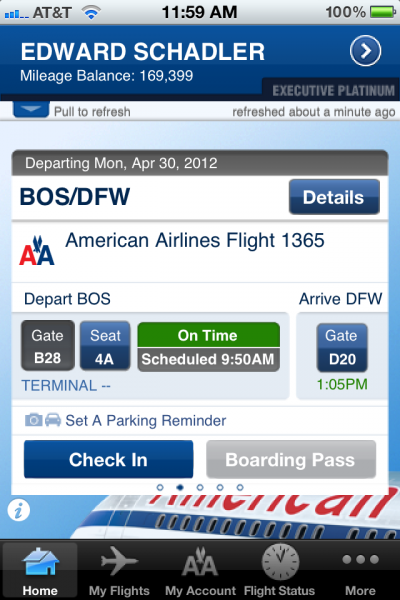What “Design For Mobile First!” Really Means
It's been three months since we published "Mobile Is The New Face Of Engagement," and we've learned a lot by listening to CIO customers and industry professionals talk about the stories and strategy of mobile engagement.
The thing that leaves people scratching their heads is the mantra, Design for mobile first! "What does that mean, exactly?," they ask. "Is it about user interface design?" The industry answer is that it's about user experience design, but that's not quite right. Design for mobile first! is really about business design. Let's start with a thought experiment to re-imagine what's possible on a touchscreen device:
Imagine that your service is in your customer's pocket at all times. Imagine what you could do with that honor.
You could serve your customers in their moments of need. You could use data from device sensors and your own data to understand their context, the time of day, where they are, what they did last time, what they prefer, even their blood pressure, weight, and anxiety level. You could design your mobile experience to be snappy, simple, and built around an "action button" to (you guessed it) help them take the next most likely action.
With the right data and predictive analytics, you could anticipate your customer's next move and light up the correct action button before they even know they need it. You could serve them anywhere at any time. Not just give them self-service mobile access to your shrunken Web site or forms-based transaction system, but truly serve them by placing information and action and control into their hands.
The American Airlines app on an iPhone is a good example of mobile engagement. The app interface changes based on my context. It lights up action buttons like "check in" and "boarding pass" based on what time it is and what my next flight is. (And if they're really thinking about my needs, the app might know that I'm scrambling to make a connecting flight and use the airport service APIs to let me know that the nearest Peet's coffee is opposite gate C22, on my way to the next flight at C27.)
To accomplish this kind of service, you have to think about how everything in your business supports your mobile engagement goals. Mobile is not just another channel. It is the most important channel for customer engagement. So Design for mobile first! starts with business design.
Mastering Mobile Engagement
Forrester believes that in order to serve your customers on their touchscreen devices over the App Internet, you will have to master mobile engagement and Design for mobile first! We define mobile engagement thus:
Mobile engagement means empowering people to take the next most likely action in their moments of need.
To accomplish that lofty goal, Design for mobile first! is a process to:
- Understand what your customers are trying to accomplish in their moments of need. And that means walking a mile in your customers' shoes so you know why they reach into their pocket to fire up an app and what, specifically, they are trying to accomplish. It means putting your customer's context at the core of the offering. It's why "experience design" agencies like SapientNitro and Deloitte Digital and Cynergy are selling mobile app gigs.
- Design your business services to intersect your customer's daily life or work. That means figuring out how what you do matches up with what they need — and changing what you do! And that requires re-imagining smartphones and tablets as a service channel and not just another "small Web" opportunity for self-service. Mobile is not small Web. Mobile is a service to inject your business value into your customers' hands in their moments of need. Done right, your mobile service is always on in my pocket, not something I have to fetch over the Web. This is where the heavy lifting and real business re-engineering happens. This is where CEOs and product owners get involved. This is where the big money will be spent.
- Design your systems of engagement to deliver a task-oriented service experience. And that requires you to "atomize" your business processes, to divide them up into the small chunks that customers care about and can interact with. This is where the technology gets important and hard. And it's still coming together. Vendors like Appian and Leapfactor and appsFreedom and Kony Solutions and IBM's WebSphere-based foundation for mobile computing are starting to build cloud-connected engagement platforms to tie content, systems of record, social feeds, device data, SaaS services, and especially analytics together to serve customers in their pocket. This is where IT and a new "chief mobility officer" must step up to work more closely with business people. This is a 5-8 year technology platforms journey that's only two years old.
- Design and operate your mobile app to help customers take the next most likely action. And that means mastering task-oriented experience design. It means designing around action buttons, not forms. It means putting performance and responsiveness on equal footing with interface and brand. It means building analytics and social feedback into the app itself. It means putting customer context and social networking and predictive analytics at the core of the engagement.
So designing for mobile first means way more than HTML5 versus native apps. It's more about designing the business for mobile service. And it's hard to do, but it's worth it. Need proof? USAA saw its mobile transaction volume soar from a projected 20 million per month to an actual 120 million per month because of its success in serving customers on their smartphones with mobile check deposits and other banking services. That's goodness. See the AA mobile app below for a simple example of mobile engagement. I rarely use www.aa.com any more.
Lastly, what applies to customer mobile engagement applies to partner engagement — helping business customers and partners take the next most likely action in a sales meeting as Trane does or in a service call as GE and Caterpillar do. And it applies to employee engagement, making employees take action and be productive and successful anywhere at any time on any device as Box and Cisco WebEx and Evernote do.
What's your mobile engagement strategy?
Figure 1 – 3 American Airlines iPhone App With Next Most Likely Action Buttons



